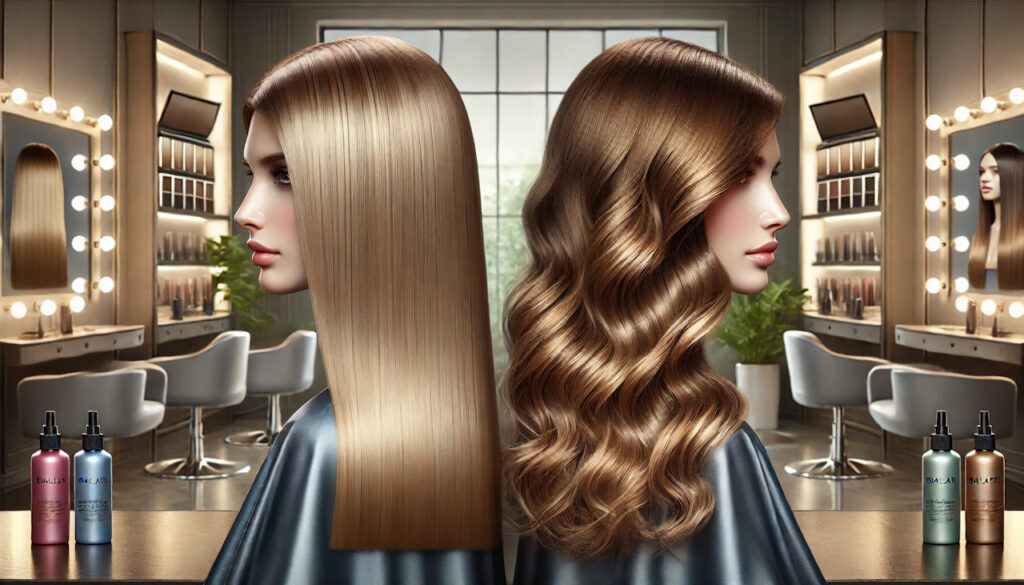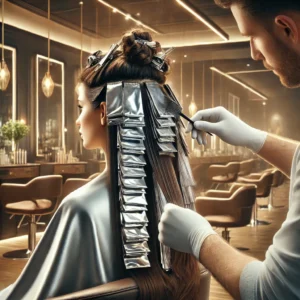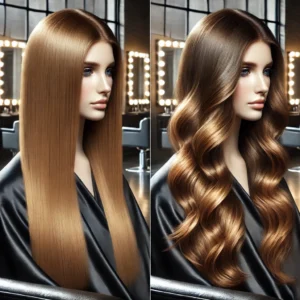Discover the Key Differences Between Foiling and Balayage Hair Highlighting Techniques
When considering a fresh and transformative look, exploring hair highlighting techniques such as Foiling and balayage can be incredibly rewarding. Both methods are designed to enhance your hair with stunning highlights, but they employ strikingly different application processes and yield distinct visual results. Foiling involves meticulously wrapping sections of hair in foil after applying a lightening agent or dye, allowing for precise highlight placement that many individuals prefer for its clarity and definition.
This careful technique leads to a polished and sophisticated hairstyle that’s perfect for those seeking a bold transformation or a dramatic contrast against their natural base color. In contrast, balayage offers a more artistic approach, where stylists hand-paint color onto hair, concentrating on the mid-lengths and ends while maintaining darker roots for a naturally sun-kissed effect. The gradual transitions associated with balayage typically require less frequent maintenance, making it a favored choice for individuals who appreciate a relaxed, lived-in look that continues to evolve beautifully over time.
Understanding these fundamental distinctions is essential for making an informed decision that aligns with your unique style and daily lifestyle requirements.

Essential Factors to Consider When Choosing Between Foiling and Balayage
- Foiling involves wrapping sections of hair in foil for precise, uniform highlights, whereas balayage uses a freehand technique that results in a more organic, sun-kissed appearance.
- Foiling has benefits, including achieving consistent and controlled results and effectively lightening hair colors; however, it can result in noticeable regrowth and may create a more structured, less natural look.
- In contrast, balayage is celebrated for its low-maintenance characteristics and seamless blending with your natural hair color. Nonetheless, it may lead to uneven color distribution and necessitate regular touch-ups.
- For individuals with thick, dark, or coarse hair, foiling can be especially beneficial, particularly if a dramatic, high-contrast look is desired.
- On the other hand, balayage is often better suited for fine or thin hair, as it offers a subtle, blended effect that minimizes the visibility of regrowth.
- To keep foiled highlights looking their best, it is crucial to use color-safe products, limit heat styling, and schedule regular touch-up appointments with your stylist.
- For those with balayage, employing color-safe products, reducing sun exposure, and maintaining regular toning sessions with your stylist will keep your highlights fresh and vibrant.
- When deciding between foiling and balayage, consider your desired aesthetic, hair type, maintenance preferences, and budget to make the most informed choice based on the pros and cons of each technique.
 Advantages of Foiling: Why It Remains a Top Choice for Hair Highlighting
Advantages of Foiling: Why It Remains a Top Choice for Hair Highlighting
Foiling presents several compelling advantages that make it a preferred option for individuals seeking vibrant and eye-catching highlights. The technique’s most notable benefit lies in its precision, as each hair section is carefully wrapped in foil, allowing for accurate color application exactly where desired. This precision is particularly advantageous for those with darker hair hues who want to achieve significant lift or contrast without compromising the integrity of their color.
Additionally, the uniformity achieved through foiling is ideal for people who appreciate a polished and sophisticated finish. However, it’s important to consider the potential drawbacks associated with this method. The foiling process can be time-consuming, often lasting several hours, especially for those with long or thick hair. Moreover, the foils can trap heat and intensify the lightening process, which could lead to hair damage if not executed with care. If you have a busy lifestyle or prefer a low-maintenance hair care routine, you might find that foiling requires more upkeep than you are willing to commit to.
Exploring the Benefits and Drawbacks of Balayage Hair Highlighting
Balayage offers numerous advantages that resonate with those desiring a more natural and effortless hairstyle. One of the standout features of this technique is its low-maintenance nature. Since balayage highlights are strategically applied to mimic natural sun exposure, they grow out gracefully, avoiding harsh lines or noticeable regrowth that can often plague other highlighting methods. This quality translates into fewer salon visits for touch-ups, making balayage an excellent choice for individuals with busy lifestyles.
However, it is essential to acknowledge that balayage may not provide the same level of contrast or vibrancy as foiling. If you’re on the hunt for bold, dramatic highlights, you may find that balayage doesn’t deliver the intensity you seek. Additionally, the success of balayage heavily relies on the skill and artistry of the stylist. Therefore, it’s crucial to select an experienced professional who can interpret and execute your vision accurately to achieve the desired results.
Identifying Hair Types That Benefit Most from Foiling Techniques
Foiling is particularly advantageous for certain hair types and textures. For individuals with thick or coarse hair, foiling can create vibrant highlights that stand out distinctly against their natural base color. The precision involved in foiling allows for targeted color placement, enhancing the hair’s natural texture and dimension remarkably. Furthermore, those with naturally dark hair looking for significant lift or contrast often find foiling to be the most effective highlighting method available.
Even individuals with fine or thin hair can benefit from foiling, as this technique can create an illusion of volume and depth. By strategically placing highlights throughout the hair, the result is added dimension that makes your locks appear fuller and more dynamic. However, if your hair is overly damaged or fragile, it is vital to consult with your stylist before opting for foiling, as the process can be more taxing on delicate strands and may exacerbate existing issues.
 Hair Types Perfectly Suited for Balayage Techniques
Hair Types Perfectly Suited for Balayage Techniques
Balayage excels in versatility and adaptability, making it a popular highlighting choice across various hair types. If you have naturally wavy or curly hair, this technique beautifully enhances your texture while providing an effortlessly chic, sun-kissed effect. The freehand application method allows for gentle color transitions, making it particularly suited for individuals seeking an organic look that complements their natural waves.
Straight hair also benefits from balayage, as it introduces movement and depth without overwhelming the base color. For those with fine hair, balayage can create an illusion of thickness by adding depth through strategically placed highlights. However, if your hair is very dark and you’re looking for a dramatic change, remember that balayage may require multiple sessions to achieve the desired brightness, especially compared to the more immediate results of foiling.
Essential Strategies for Maintaining Vibrant Foiled Highlights
Maintaining the vibrancy of foiled highlights requires a commitment to preserving your color and keeping it fresh. A crucial step is to use sulfate-free shampoos and conditioners specifically formulated for color-treated hair. These specialized products help to preserve your highlights while preventing fading and damage that can occur with regular cleansing routines.
Incorporating a deep conditioning treatment into your hair care regimen at least once a week is also vital for keeping your hair hydrated, nourished, and healthy. Regular trips to the salon are essential for maintaining the integrity of foiled highlights. Depending on your hair growth rate and how noticeable your regrowth is, you might need touch-ups every 6 to 8 weeks. During these appointments, your stylist can refresh your highlights and ensure they remain vibrant and harmoniously blended with your natural base color. Lastly, be proactive about protecting your hair from heat damage by using heat protectants before styling and minimizing exposure to high temperatures whenever possible.
Best Practices for Caring for Balayage Highlights
Caring for balayage highlights typically involves a more straightforward approach and less effort than maintaining foiled highlights, thanks to their naturally low-maintenance characteristics. Select color-safe shampoos and conditioners that nourish your hair without stripping away color to keep your balayage looking its best. Look for products enriched with natural oils or proteins that help to maintain moisture levels while enhancing overall shine.
Although balayage requires fewer touch-ups compared to foiling, regular salon visits remain essential to ensure your color stays fresh and vibrant. Depending on how quickly your hair grows and the amount of lightening you desire over time, consider scheduling appointments every 8 to 12 weeks for a refresh. During these visits, your stylist can evaluate your hair’s health and make any necessary adjustments to maintain that beautiful, sun-kissed effect you aspire to achieve.
 Making the Right Choice: Foiling vs. Balayage Highlighting Techniques
Making the Right Choice: Foiling vs. Balayage Highlighting Techniques
Ultimately, selecting between foiling and balayage should be guided by your personal style preferences and lifestyle considerations. If you seek bold, defined highlights with a polished finish, foiling may be the most fitting option for you. This technique enables precise color placement and can create stunning contrasts that make a powerful visual statement.
Conversely, if you prefer a natural look that demands less maintenance, balayage may be the ideal technique. It offers versatility and adaptability for a variety of hair types while providing an effortlessly chic aesthetic that matures beautifully over time. When making your choice, consider your hair type, desired maintenance level, and overall visual goal. Both foiling and balayage come with unique benefits and challenges. By understanding these differences and evaluating your style alongside your lifestyle needs, you can confidently select the technique that best aligns with your aspirations. Whether you choose the precision of foiling or the effortless beauty of balayage, both methods can enhance your look and elevate your confidence.
Your Frequently Asked Questions Addressed
What does the foiling technique involve in hair coloring?
Foiling is a highlighting technique that consists of isolating sections of hair and wrapping them in foil before applying color. This method enables precise placement of highlights, resulting in a more uniform and controlled color effect throughout the hair.
What distinguishes the balayage highlighting technique?
Balayage is a highlighting method where color is hand-painted directly onto the hair to achieve a natural, sun-kissed effect. This approach allows for softer transitions and a more blended appearance, resulting in highlights that grow out seamlessly and naturally over time.
How do foiling and balayage differ from each other?
Foiling creates a more uniform, all-over color effect with precise highlight placement, while balayage delivers a natural, sun-kissed look characterized by softer, blended highlights. Generally, foiling requires more maintenance due to noticeable regrowth, whereas balayage grows out more smoothly and requires less frequent touch-ups.
Which highlighting technique is best for my hair type?
The choice between foiling and balayage depends on your desired look and maintenance preferences. If you prefer uniform color with precise highlight placement, foiling may be the ideal choice. Conversely, if you desire a natural, sun-kissed appearance with softer highlights and less visible regrowth, balayage is likely the better option. Consulting with a professional hairstylist can provide personalized recommendations based on your hair type and desired outcomes.
Presented By: Hair Foiling
The Article: Highlighting Techniques: Foiling vs. Balayage Explained appeared first on Amitys Hair Salon.
The Article Foiling vs. Balayage: Key Highlighting Techniques Explained Was Found On https://limitsofstrategy.com

I appreciate the detailed exploration of foiling and balayage techniques. It’s interesting how these highlighting methods can significantly impact not just the visual outcome of hair color but also how they contribute to an individual’s identity and self-expression. In my experience, I have noticed that the choice between foiling and balayage often reflects a person’s personality and lifestyle.
Your exploration of the differences between foiling and balayage truly resonates with anyone who has experienced a hair transformation or is thinking about it. I appreciate how you highlighted the meticulous nature of foiling, which indeed lends itself to a strikingly defined look. I remember the first time I opted for foiling—my stylist spent what felt like hours wrapping foil around each section. The result was so vibrant and bold that I received compliments for weeks! It’s definitely a great choice for someone looking to make a statement.
I really appreciate this deep dive into foiling and balayage! Both techniques have their unique charms that cater to different vibes and personalities, and as someone who has tried both, I can definitely see the value in understanding these differences more thoroughly.